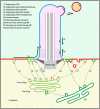Transport of Ciliary Membrane Proteins
- PMID: 31998723
- PMCID: PMC6970386
- DOI: 10.3389/fcell.2019.00381
Transport of Ciliary Membrane Proteins
Abstract
Cilia and flagella are highly conserved organelles in eukaryotic cells that drive cell movement and act as cell antennae that receive and transmit signals. In addition to receiving and transducing external signals that activate signal cascades, cilia also secrete ciliary ectosomes that send signals to recipient cells, and thereby mediate cell-cell communication. Abnormal ciliary function leads to various ciliopathies, and the precise transport and localization of ciliary membrane proteins are essential for cilium function. This review summarizes current knowledge about the transport processes of ciliary membrane proteins after their synthesis at the endoplasmic reticulum: modification and sorting in the Golgi apparatus, transport through vesicles to the ciliary base, entrance into cilia through the diffusion barrier, and turnover by ectosome secretion. The molecular mechanisms and regulation involved in each step are also discussed. Transport of ciliary membrane proteins is a complex, precise cellular process coordinated among multiple organelles. By systematically analyzing the existing research, we identify topics that should be further investigated to promote progress in this field of research.
Keywords: cilia; ciliary ectosome; ciliary membrane protein; ciliopathies; diffusion barrier.
Copyright © 2020 Long and Huang.
Figures

References
Publication types
LinkOut - more resources
Full Text Sources

